Abstract
The biological activities in vivo and in vitro of 59 motile Aeromonas spp. isolated from fish and water tanks were simultaneously analyzed in poikilothermic and homoiothermic systems. A total of 64.3% of the isolates tested were pathogenic for fish, and 62% of Aeromonas hydrophila and A. sobria isolates either virulent or nonvirulent for fish were enterotoxigenic. Although the majority of the strains were proteolytic and amylolytic and produced DNase, other activities, such as elastase and staphylolysis, were only present in A. hydrophila. Most of the strains (96%) produced hemolysins, and 68% had agglutinating capacity, but neither isolates pathogenic for fish nor enterotoxigenic isolates showed specificity for trout or human erythrocytes, respectively. The production of siderophores, agglutination in acriflavine, and precipitation after boiling were found not to be useful tests for screening virulent strains. Although statistical analysis revealed a significant relationship between virulence for fish and positive results for arabinose and sucrose fermentations, elastase, and hemolysis of human erythrocytes, only lysine decarboxylase showed a significant positive relationship with enterotoxigenicity. Using extracellular products from representative Aeromonas strains with different virulence markers and belonging to distinct O serogroups, we demonstrated a lack of correlation between cytotoxicity for fish and homoiothermic cell lines and pathogenicity. The extracellular products from selected pathogenic A. hydrophila strains were lethal for rainbow trout and displayed proteolytic, hemolytic, and cytotoxic activities which were simultaneously lost after heat treatment. The findings reported here indicate that it is not possible to establish a common and single mechanism involved in the invasion of Aeromonas spp. in poikilothermic and homoiothermic hosts.
Full text
PDF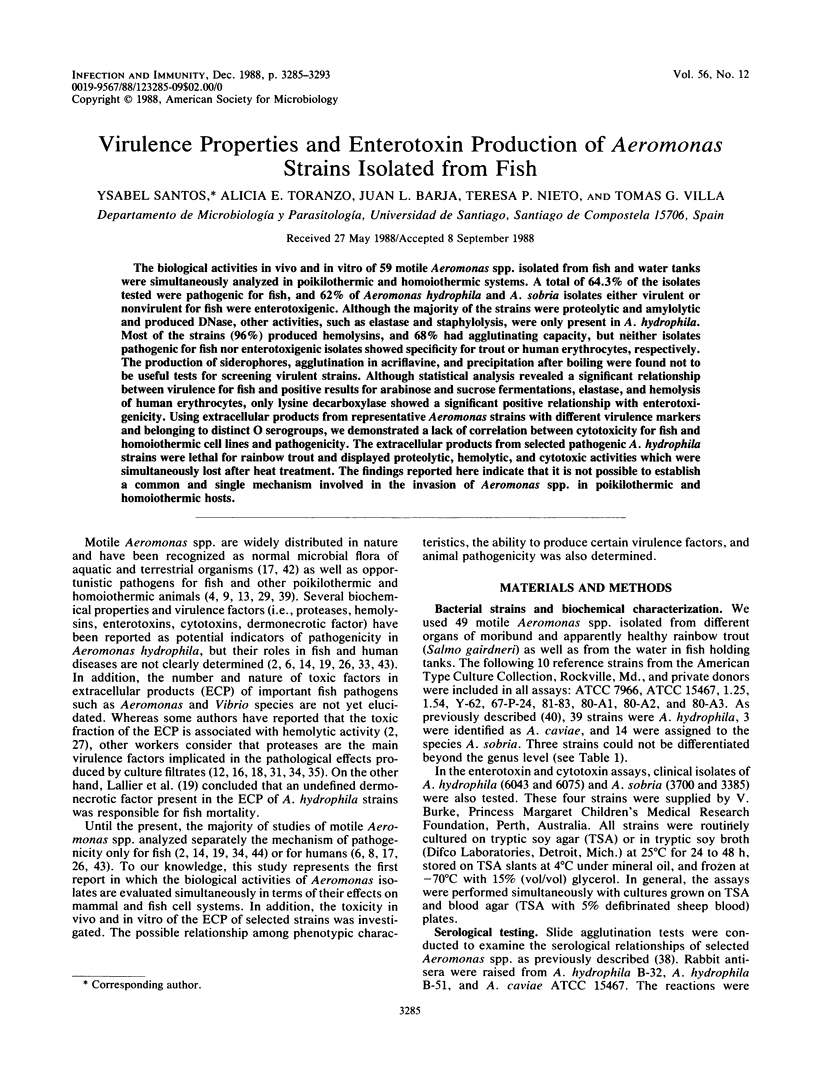
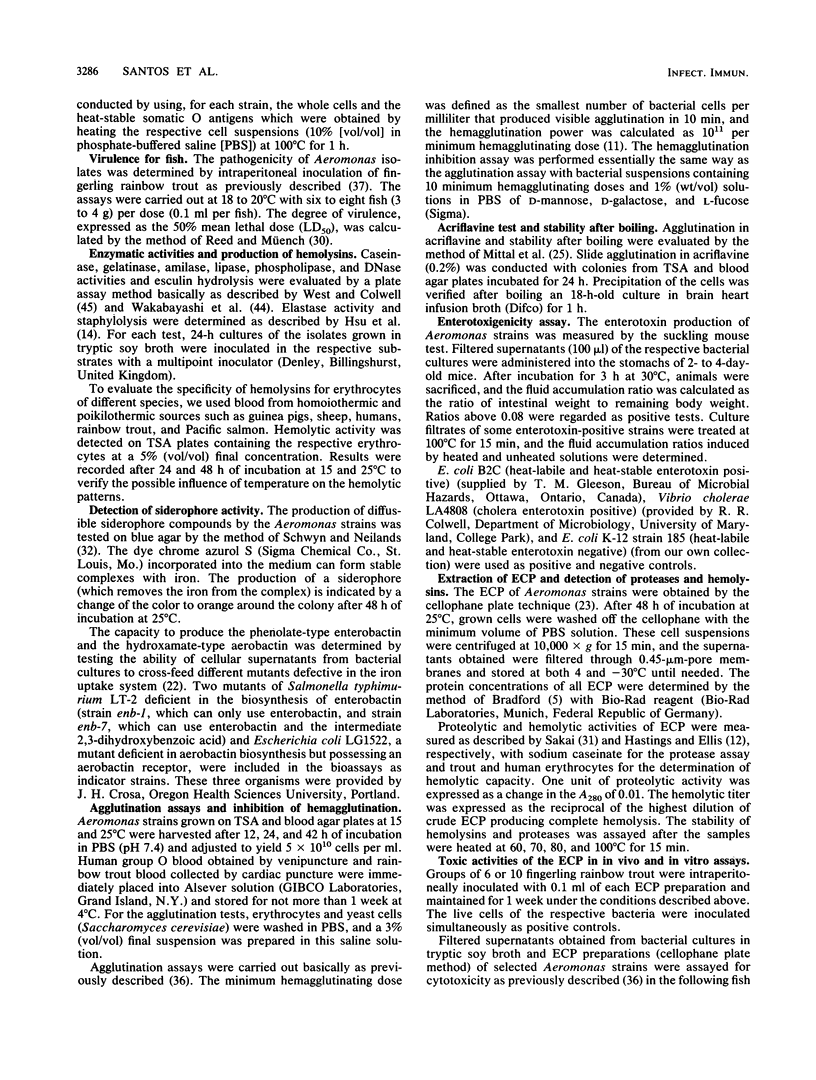

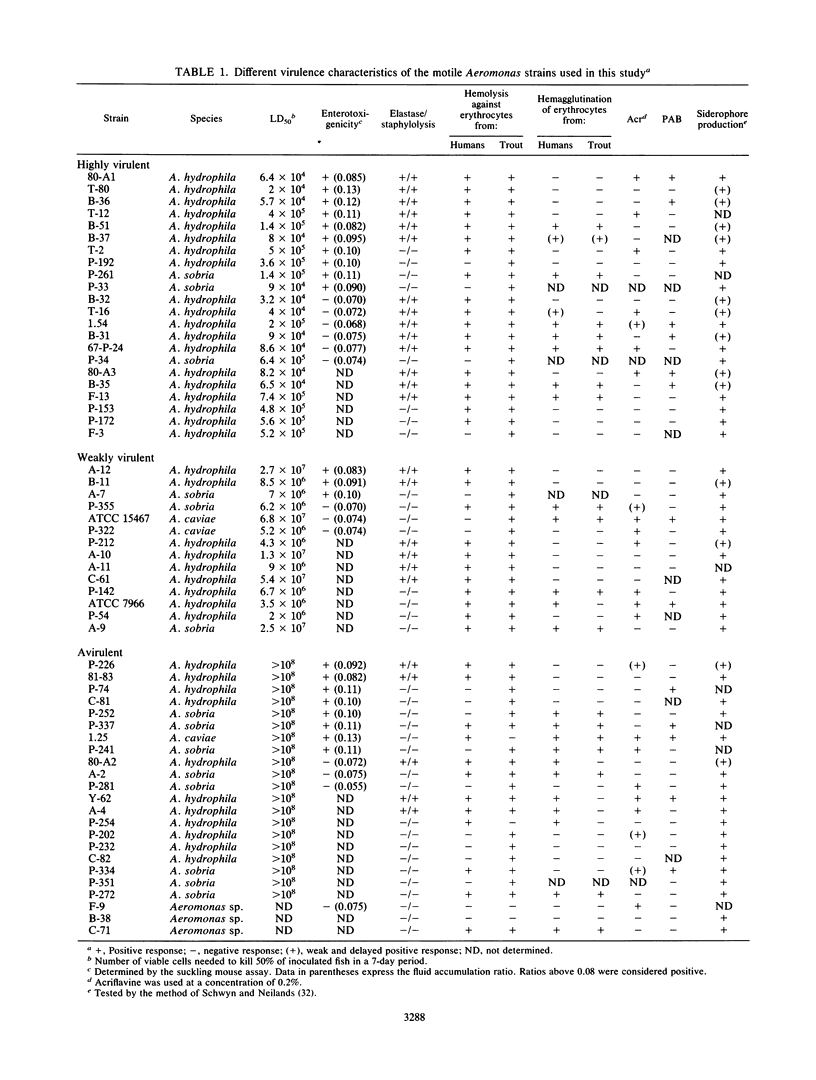
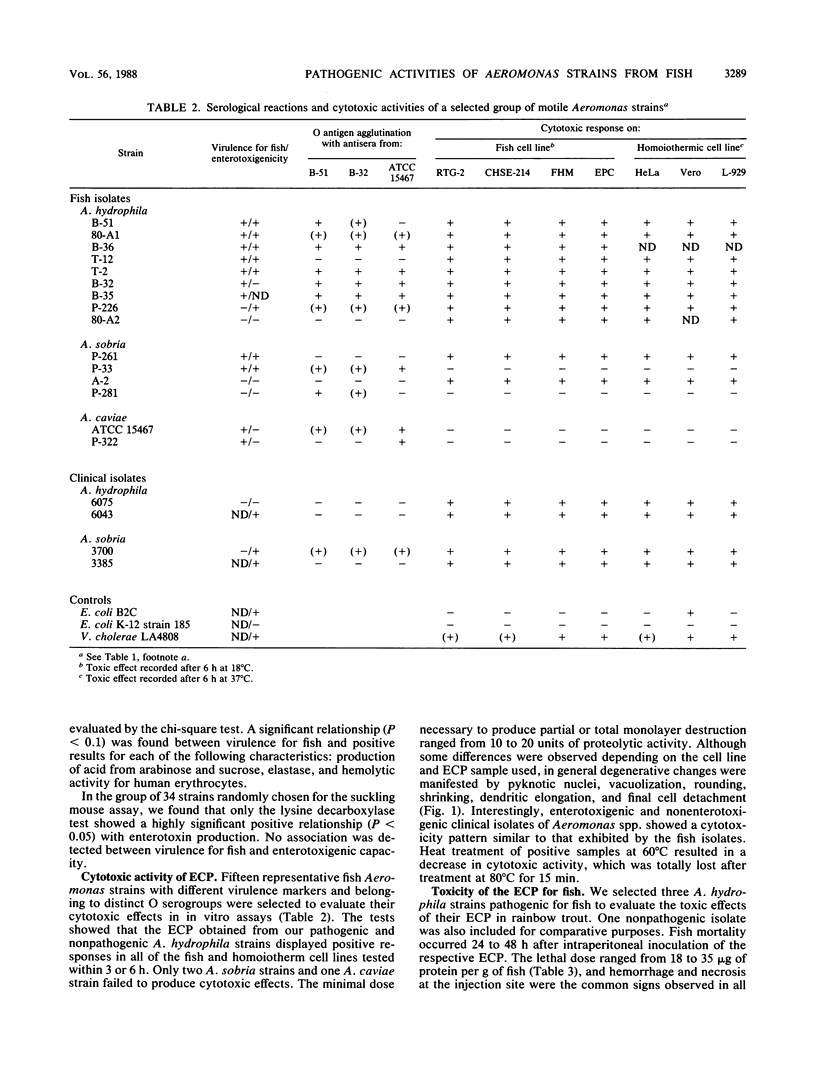
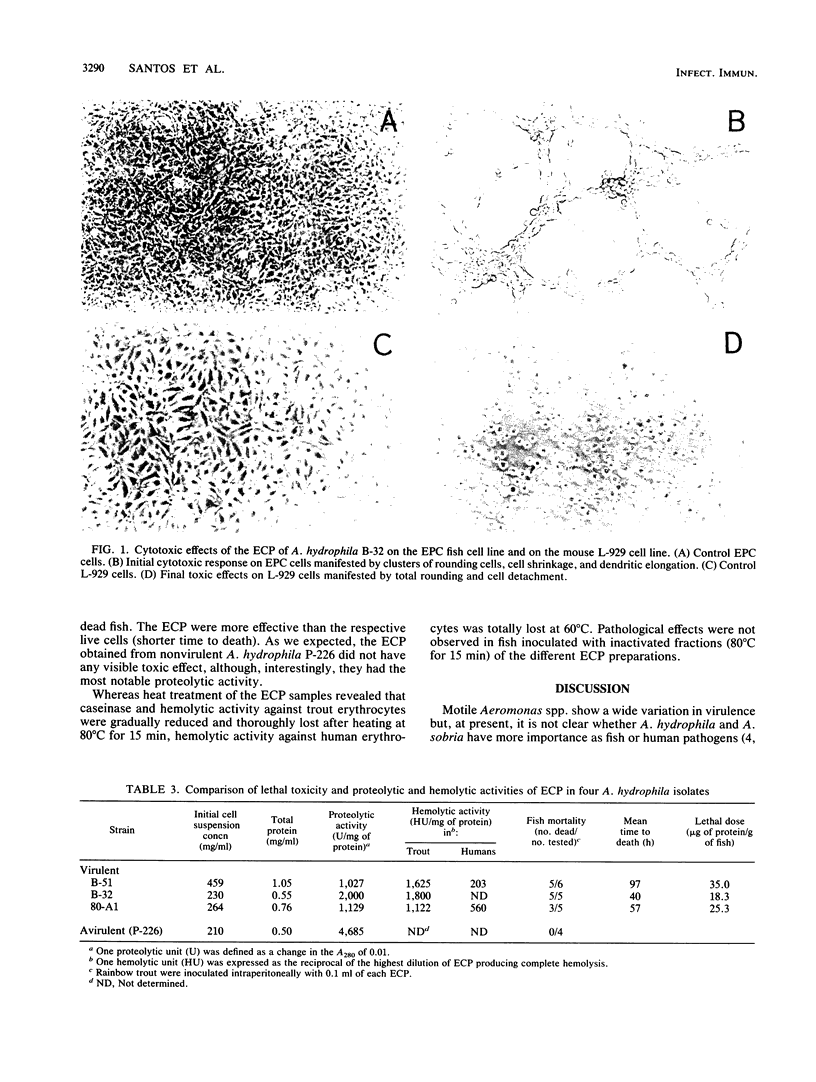
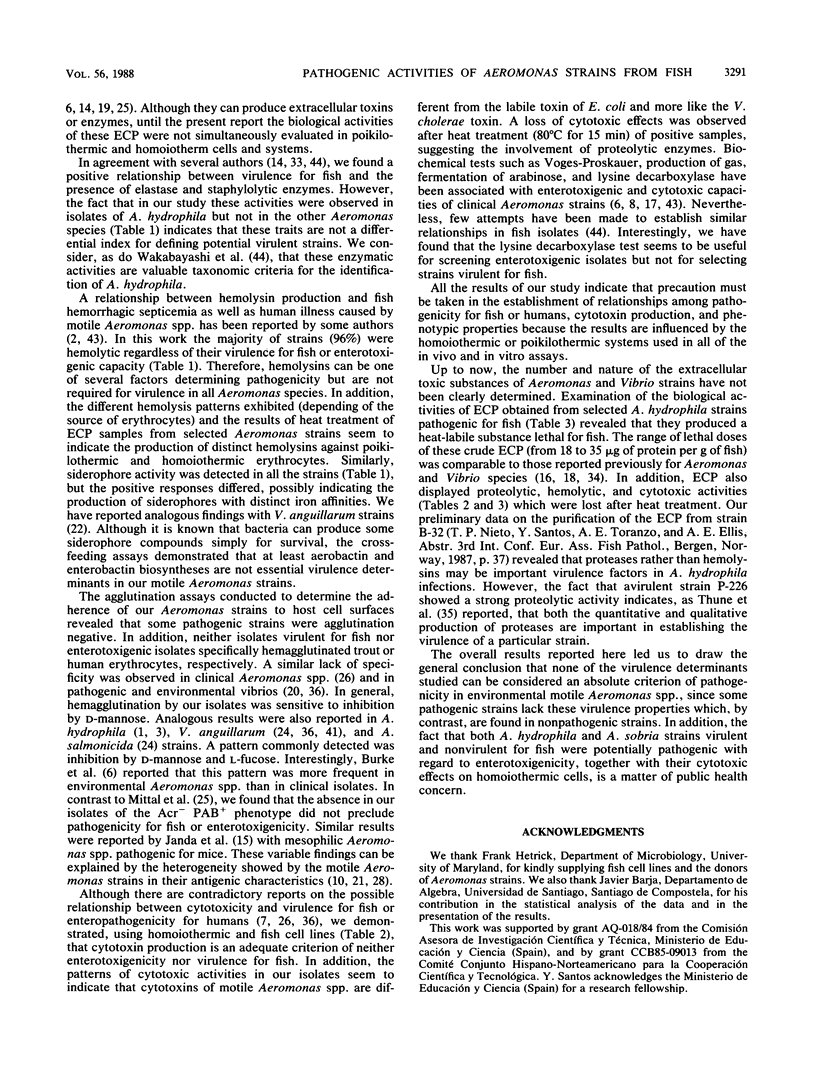


Images in this article
Selected References
These references are in PubMed. This may not be the complete list of references from this article.
- Adams D., Atkinson H. M., Woods W. H. Aeromonas hydrophila typing scheme based on patterns of agglutination with erythrocytes and yeast cells. J Clin Microbiol. 1983 Mar;17(3):422–427. doi: 10.1128/jcm.17.3.422-427.1983. [DOI] [PMC free article] [PubMed] [Google Scholar]
- Allan B. J., Stevenson R. M. Extracellular virulence factors of Aeromonas hydrophila in fish infections. Can J Microbiol. 1981 Oct;27(10):1114–1122. doi: 10.1139/m81-174. [DOI] [PubMed] [Google Scholar]
- Atkinson H. M., Trust T. J. Hemagglutination properties and adherence ability of Aeromonas hydrophila. Infect Immun. 1980 Mar;27(3):938–946. doi: 10.1128/iai.27.3.938-946.1980. [DOI] [PMC free article] [PubMed] [Google Scholar]
- Boulanger Y., Lallier R., Cousineau G. Isolation of enterotoxigenic Aeromonas from fish. Can J Microbiol. 1977 Sep;23(9):1161–1164. doi: 10.1139/m77-174. [DOI] [PubMed] [Google Scholar]
- Bradford M. M. A rapid and sensitive method for the quantitation of microgram quantities of protein utilizing the principle of protein-dye binding. Anal Biochem. 1976 May 7;72:248–254. doi: 10.1006/abio.1976.9999. [DOI] [PubMed] [Google Scholar]
- Burke V., Robinson J., Cooper M., Beaman J., Partridge K., Peterson D., Gracey M. Biotyping and virulence factors in clinical and environmental isolates of Aeromonas species. Appl Environ Microbiol. 1984 May;47(5):1146–1149. doi: 10.1128/aem.47.5.1146-1149.1984. [DOI] [PMC free article] [PubMed] [Google Scholar]
- Cumberbatch N., Gurwith M. J., Langston C., Sack R. B., Brunton J. L. Cytotoxic enterotoxin produced by Aeromonas hydrophila: relationship of toxigenic isolates to diarrheal disease. Infect Immun. 1979 Mar;23(3):829–837. doi: 10.1128/iai.23.3.829-837.1979. [DOI] [PMC free article] [PubMed] [Google Scholar]
- DUGUID J. P. Fimbriae and adhesive properties in Klebsiella strains. J Gen Microbiol. 1959 Aug;21:271–286. doi: 10.1099/00221287-21-1-271. [DOI] [PubMed] [Google Scholar]
- Davis W. A., 2nd, Kane J. G., Garagusi V. F. Human aeromonas infections: a review of the literature and a case report of endocarditis. Medicine (Baltimore) 1978 May;57(3):267–277. [PubMed] [Google Scholar]
- Dooley J. S., Lallier R., Shaw D. H., Trust T. J. Electrophoretic and immunochemical analyses of the lipopolysaccharides from various strains of Aeromonas hydrophila. J Bacteriol. 1985 Oct;164(1):263–269. doi: 10.1128/jb.164.1.263-269.1985. [DOI] [PMC free article] [PubMed] [Google Scholar]
- Hazen T. C., Fliermans C. B., Hirsch R. P., Esch G. W. Prevalence and distribution of Aeromonas hydrophila in the United States. Appl Environ Microbiol. 1978 Nov;36(5):731–738. doi: 10.1128/aem.36.5.731-738.1978. [DOI] [PMC free article] [PubMed] [Google Scholar]
- Janda J. M., Oshiro L. S., Abbott S. L., Duffey P. S. Virulence markers of mesophilic aeromonads: association of the autoagglutination phenomenon with mouse pathogenicity and the presence of a peripheral cell-associated layer. Infect Immun. 1987 Dec;55(12):3070–3077. doi: 10.1128/iai.55.12.3070-3077.1987. [DOI] [PMC free article] [PubMed] [Google Scholar]
- Kaper J. B., Lockman H., Colwell R. R., Joseph S. W. Aeromonas hydrophila: ecology and toxigenicity of isolates from an estuary. J Appl Bacteriol. 1981 Apr;50(2):359–377. doi: 10.1111/j.1365-2672.1981.tb00900.x. [DOI] [PubMed] [Google Scholar]
- LIU P. V. Survey of hemolysin production among species of pseudomonads. J Bacteriol. 1957 Dec;74(6):718–727. doi: 10.1128/jb.74.6.718-727.1957. [DOI] [PMC free article] [PubMed] [Google Scholar]
- Lallier R., Bernard F., Lalonde G. Difference in the extracellular products of two strains of Aeromonas hydrophila virulent and weakly virulent for fish. Can J Microbiol. 1984 Jul;30(7):900–904. doi: 10.1139/m84-141. [DOI] [PubMed] [Google Scholar]
- Larsen J. L., Mellergaard S. Agglutination Typing of Vibrio anguillarum Isolates from Diseased Fish and from the Environment. Appl Environ Microbiol. 1984 Jun;47(6):1261–1265. doi: 10.1128/aem.47.6.1261-1265.1984. [DOI] [PMC free article] [PubMed] [Google Scholar]
- Leblanc D., Mittal K. R., Olivier G., Lallier R. Serogrouping of motile Aeromonas species isolated from healthy and moribund fish. Appl Environ Microbiol. 1981 Jul;42(1):56–60. doi: 10.1128/aem.42.1.56-60.1981. [DOI] [PMC free article] [PubMed] [Google Scholar]
- Lemos M. L., Salinas P., Toranzo A. E., Barja J. L., Crosa J. H. Chromosome-mediated iron uptake system in pathogenic strains of Vibrio anguillarum. J Bacteriol. 1988 Apr;170(4):1920–1925. doi: 10.1128/jb.170.4.1920-1925.1988. [DOI] [PMC free article] [PubMed] [Google Scholar]
- Mittal K. R., Lalonde G., Leblanc D., Olivier G., Lallier R. Aeromonas hydrophila in rainbow trout: relation between virulence and surface characteristics. Can J Microbiol. 1980 Dec;26(12):1501–1503. doi: 10.1139/m80-248. [DOI] [PubMed] [Google Scholar]
- Morgan D. R., Johnson P. C., DuPont H. L., Satterwhite T. K., Wood L. V. Lack of correlation between known virulence properties of Aeromonas hydrophila and enteropathogenicity for humans. Infect Immun. 1985 Oct;50(1):62–65. doi: 10.1128/iai.50.1.62-65.1985. [DOI] [PMC free article] [PubMed] [Google Scholar]
- Olivier G., Lallier R., Larivière S. A toxigenic profile of Aeromonas hydrophila and Aeromonas sobria isolated from fish. Can J Microbiol. 1981 Mar;27(3):330–333. doi: 10.1139/m81-050. [DOI] [PubMed] [Google Scholar]
- Sakai D. K. Loss of virulence in a protease-deficient mutant of Aeromonas salmonicida. Infect Immun. 1985 Apr;48(1):146–152. doi: 10.1128/iai.48.1.146-152.1985. [DOI] [PMC free article] [PubMed] [Google Scholar]
- Schwyn B., Neilands J. B. Universal chemical assay for the detection and determination of siderophores. Anal Biochem. 1987 Jan;160(1):47–56. doi: 10.1016/0003-2697(87)90612-9. [DOI] [PubMed] [Google Scholar]
- Toranzo A. E., Barja J. L., Potter S. A., Colwell R. R., Hetrick F. M., Crosa J. H. Molecular factors associated with virulence of marine vibrios isolated from striped bass in Chesapeake Bay. Infect Immun. 1983 Mar;39(3):1220–1227. doi: 10.1128/iai.39.3.1220-1227.1983. [DOI] [PMC free article] [PubMed] [Google Scholar]
- Toranzo A. E., Santos Y., Nieto T. P., Barja J. L. Evaluation of different assay systems for identification of environmental Aeromonas strains. Appl Environ Microbiol. 1986 Mar;51(3):652–656. doi: 10.1128/aem.51.3.652-656.1986. [DOI] [PMC free article] [PubMed] [Google Scholar]
- Trust T. J., Courtice I. D., Khouri A. G., Crosa J. H., Schiewe M. H. Serum resistance and hemagglutination ability of marine vibrios pathogenic for fish. Infect Immun. 1981 Dec;34(3):702–707. doi: 10.1128/iai.34.3.702-707.1981. [DOI] [PMC free article] [PubMed] [Google Scholar]
- Trust T. J., Sparrow R. A. The bacterial flora in the alimentary tract of freshwater salmonid fishes. Can J Microbiol. 1974 Sep;20(9):1219–1228. doi: 10.1139/m74-188. [DOI] [PubMed] [Google Scholar]
- Turnbull P. C., Lee J. V., Miliotis M. D., Van de Walle S., Koornhof H. J., Jeffery L., Bryant T. N. Enterotoxin production in relation to taxonomic grouping and source of isolation of Aeromonas species. J Clin Microbiol. 1984 Feb;19(2):175–180. doi: 10.1128/jcm.19.2.175-180.1984. [DOI] [PMC free article] [PubMed] [Google Scholar]



